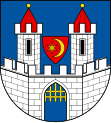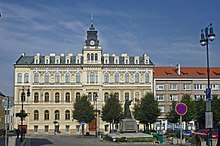Louny
| Louny | ||||
|---|---|---|---|---|
|
||||
| Basic data | ||||
| State : |
|
|||
| Historical part of the country : | Bohemia | |||
| Region : | Ústecký kraj | |||
| District : | Louny | |||
| Area : | 2413.1692 ha | |||
| Geographic location : | 50 ° 21 ′ N , 13 ° 48 ′ E | |||
| Height: | 185 m nm | |||
| Residents : | 18,351 (Jan 1, 2019) | |||
| Postal code : | 440 01 | |||
| License plate : | U | |||
| traffic | ||||
| Railway connection: |
Prague – Most Lovosice – Louny Rakovník – Louny Postoloprty – Louny |
|||
| structure | ||||
| Status: | city | |||
| Districts: | 3 | |||
| administration | ||||
| Mayor : | Pavel Janda (as of 2020) | |||
| Address: | Mírové náměstí 35 440 23 Louny |
|||
| Municipality number: | 565971 | |||
| Website : | www.mulouny.cz | |||
| Location of Louny in the Louny district | ||||

|
||||
Louny (German Laun ) is a city in the northern Bohemian Aussiger region . The district town on the banks of the Eger has 18,476 inhabitants (2014) .
history
Excavations in the eastern area of the city showed that there was a Celtic settlement there. Later settled Marcomanni in the territory of the city. Excavations as well as finds prove their settlement. The first evidence of Slavic settlement comes from the 6th century. The name of the city is said to be derived from a first name Loun or Luni / Louni.
Louny was first in 1088 in a property list of King I. Vratislav listed. In 1115 the town was mentioned as the property of the Kladruby Monastery . In 1186 the city was listed in a document from Prince Friedrich . The royal city was founded by Přemysl Ottokar II in the 1260s east of the original settlement.
The city was on the trade routes from Prague to Dresden and from Nuremberg to Dresden. The travelers had to use the secured roads and spend the night in the respective cities and pay road tolls. There was a ford through the Eger, which was usable until the high tide. Later a bridge was built over the Eger and the polder . This served the king and the city as a secure source of income, because commercial travelers had to move their goods on the trade routes. The district founded by Ottokar II is located on a natural hill, because it happened and is still the case today that floods flood the still existing polder, which is now the park and exhibition area.
The previously existing older settlement area of the suburb was demolished in the 1970s. In place of the old settlement there are now prefabricated buildings . Only the oldest church in the city and the cemetery have been preserved. Many buildings from the 14th to 16th centuries were demolished, including the bathhouse with its own mineral spring. This is now under a street and is inaccessible, the spring water is directed into the Eger.
During the Hussite movement , the city was one of the restraints of the Hussites, during which time many Catholic institutions, such as a monastery in the city, were destroyed. The walls of the monastery have been partially preserved and are now used as walls for other buildings. The remaining historic city center has been preserved despite the many fires and destruction in the past.
In 1813 during the Battle of Dresden Louny was a hospital town. The still existing hospital as well as all hotels and hostels served as military hospitals. Mainly the soldiers and officers of the Russian Tsar were treated in Louny. According to legend, Tsar Alexander I came to Louny personally to make atonement to Jean-Victor-Marie Moreau .
At the end of the 19th century, the state railway lines Prague – Brüx, Laun – Rakonitz – Beraun, Laun – Postelberg and Laun – Libochowitz were built. The city became the seat of a district administration and a district court.
Around 1900 there were 10,212 inhabitants in the district town. There were sugar factories, a beer brewery, a metal goods factory, a pottery factory, and railroad repair shops.
City structure
The city of Louny consists of the districts and cadastral districts Brloh ( Bierloch ), Louny ( Laun ) and Nečichy ( Netschich ). Basic settlement units are Brloh, Březinka, Domov, Hrnčířská, Ke Pšaňáku, Louny-střed, Louny-Západ, Lužerady, Na Losech, Na Mělcích, Nad Tratí, Nádražní, Nečicha, Redova, Ciředánky, Ciředánky, Ualkřánky, Skalky, Pšaňáku, Louny-střed, Louny-Západ, Lužerady, Na Losech U Zastávky, V Americe, Vršovka, Výstaviště and Zahradní město.
Attractions
- The most valuable architectural monument that can be seen from afar is the St. Nicholas Church. The late Gothic three-nave church with towers from the 14th century was built in the years 1520–38 by the famous royal architect Benedikt Ried from Piesting in the spirit of the Vladislav Gothic . It was reconstructed at the turn of the 20th century. A gallery has been set up in Louny in his honor.
- The influence of the Jewish population in the city can be seen from the location of the preserved buildings in the city. As in the other cities, there was an enclosed area. The upper part of the former Jewish street, the so-called ghetto , today's Česká Ulice, has been preserved. The synagogue is now an archive. The Jewish cemetery is also still preserved.
- The massive city walls from the 12th century have largely been preserved and repaired. They are next to the Saaz Gate (Czech: Žatecká brána ) a testimony to the former wealth of the city and its inhabitants.
- The local museum, housed in a former mighty mansion, is dedicated to the history of the city.
- Other notable churches in Louny are the Church of St. Peter from the 14th century and the Church of the Mother of Jesus Christ from 1493.
- The building of the Czechoslovak Hussite Church on Jakoubkova Street was built in the New Objectivity style.
- The preserved mineral spring "Luna" is located on the premises of the hospital and is accessible. The water is said to have healing properties, and many people still use it today to treat cuts.
economy
In addition to the existing Czech companies, mainly Japanese companies have settled in the town of Louny as well as in the surrounding area. With around 3,500 jobs, these are the largest employers and investors in the region. Foreign specialists and workers also moved to Louny and the surrounding area. As a result, there was economic tourism, primarily from Japan, Italy and Germany.
At the same time, recreational tourism is increasing in the city. The number of guests from Russia has increased the most. The increasing economic and recreational tourism led to hotels, guesthouses and restaurants being founded. Today there are around 80 restaurants, pubs, wine bars and cafes.
Agriculturally, the town and its surroundings ( Okres Louny ) are traditionally known for the cultivation of high quality hops . In Louny, there was also a well-known beer brewery, Pivovar Louny , which was taken over by Heineken in 2008 and closed at the end of 2010.
A nature reserve borders Louny.
Twin cities
Personalities
- Jean-Victor-Marie Moreau (1763–1813), French general at the time of the revolution and the consulate, opponent and rival of Napoleon Bonaparte.
- Josef Mocker (1835–1899), architect
- Jaroslav Vrchlický (1853–1912), writer and poet
- Josef Hlaváček (1864–1944), accordion maker
- Kamil Hilbert (1869–1933), Bohemian architect
- Jaroslav Hilbert (1871–1936), playwright, prose writer and theater critic
- Václav Hlavatý (1894–1969), mathematician
- Konstantin Biebl (1898–1951), poet
- Karel Konrád (1899–1971), writer
- Zdeněk Sýkora (1920–2011), painter and sculptor
- Ladislav Novák (1931–2011), football player and coach
- Miroslav Štěpán (1945-2014), politician, communist activist and functionary of the Komunistická strana Československa (KSČ)
- Jaroslav Mucha (* 1956), ice hockey player
- Jan Alinč (* 1972), ice hockey player
- Martin Kovář (* 1977), handball player
- Karolína Plíšková (* 1992), tennis player
- Kristýna Plíšková (* 1992), tennis player
On site:
- Benedikt Ried (1454–1534), architect
literature
- Antonín Jiří Hluštík, Bohumír Roedl (eds.): Louny. Nakladatelství Lidové noviny, Prague 2005, ISBN 80-7106-662-1
- Rudolf Wunš: Dějiny svob. král. města Loun od počátku až do dob nejnovějších. Prague 1868
Individual evidence
- ↑ http://www.uir.cz/obec/565971/Louny
- ↑ Český statistický úřad - The population of the Czech municipalities as of January 1, 2019 (PDF; 7.4 MiB)
- ↑ http://www.uir.cz/casti-obce-obec/565971/Obec-Louny
- ↑ http://www.uir.cz/katastralni-uzemi-obec/565971/Obec-Louny
- ↑ http://www.uir.cz/zsj-obec/565971/Obec-Louny







